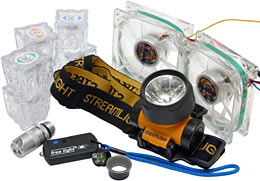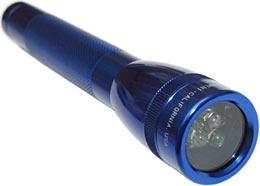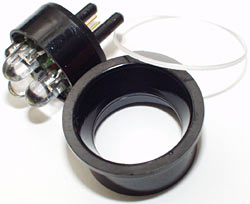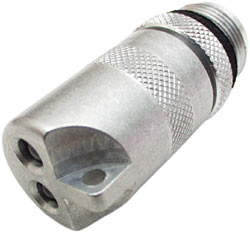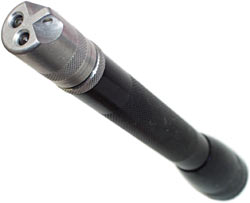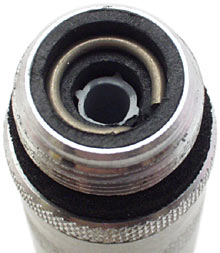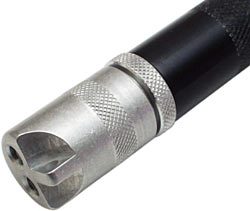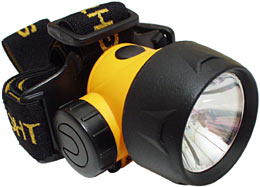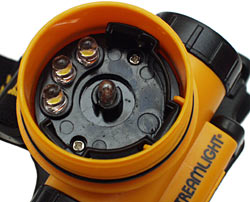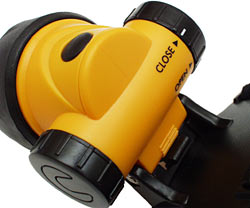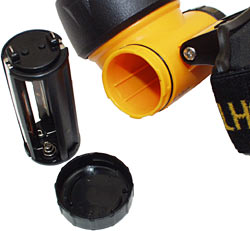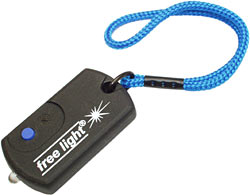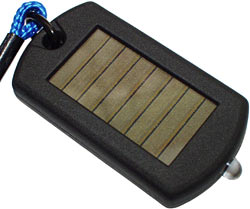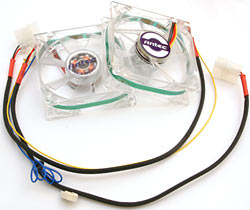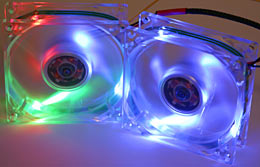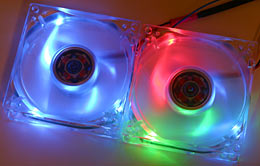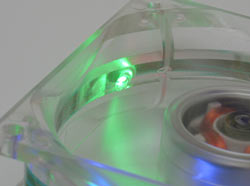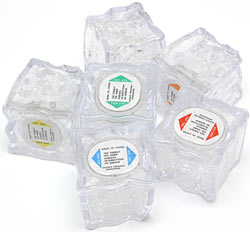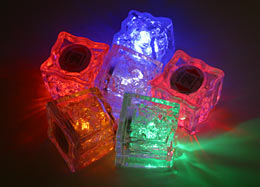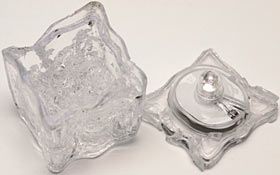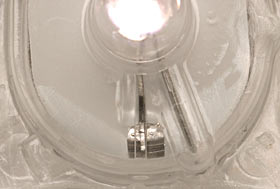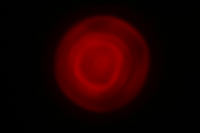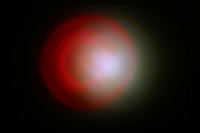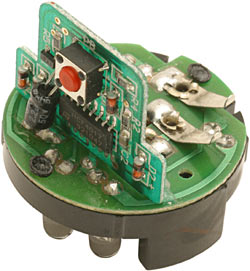
LED light roundup: Opalec NewBeam, Out-Tec Flashlight Tuner, Streamlight Trident, Avexa Free Light, Antec LED Fans, and Litecubes!
Review date: 30 July 2002.Last modified 03-Dec-2011.
Light Emitting Diodes (LEDs) aren't yet a generally able to replace incandescent bulbs. They're not bright enough or cheap enough, and it's hard to make a focussable LED light, so practically none of them offer a narrow spotlight beam. But they've also got considerable advantages - functionally infinite lamp life, excellent shock resistance, availability in a range of colours without the need for power-wasting filters, and useful light output even from almost-dead batteries.
These features have resulted in some... odd... products that're lit up by LEDs. Like computer fans, and plastic ice cubes.
But we'll get to those in a moment.
First, some more conventional lighting.
Stealth LEDs
The two-AA-cell Mini Maglite is a massively popular product, for very good reason. Basically, this is the smallest incandescent-bulb flashlight that actually works well, won't break, and can be bought cheaply. Not as cheaply as an all-plastic supermarket special, of course, but the Mini Maglite is respectably bright, is focussable, is made of tough aluminium, comes with a spare grain-of-wheat bulb in the tailcap, can run without its reflector in "candle mode", and is decently water resistant, too. So it's not a bad deal for the money - less than $AU30 (under $US15), if you shop around.
Mag Instrument have been selling these things for 18 years now, and people are still buying 'em, so the Mini Mag may safely be described as a classic. But, like other unkillable products, it's not perfect. And pretty much all of its problems centre on its incandescent bulb.
The bulb's light is rather yellow, and it's uneven, because of the bulb's uneven radiation properties, which are emphasised by the reflector. And the bulb will, of course, die altogether every now and then, leaving you to swap bulbs in the dark if you don't have a standby light.
Enthusiasts have been making LED retrofits for Mini Mags (and cheap knockoffs of the Mini Mag design) for some time, but Opalec's NewBeam kit is an elegant, quite easy to install alternative for anybody who doesn't want to roll their own LED modification.
In the NewBeam kit, you get a lamp module with three 5mm white LEDs and one smaller red one. You put the lamp module in place of the flashlight's bulb receiver widget (the part with DO NOT REMOVE stamped on it...), on the business end of the Mini Mag. You also get a black plastic ring that replaces the standard reflector, and a new plastic lens for the flashlight; the lens is for you to use if you're refitting a well-used Mini Mag whose original lens is scratched.
You have to have a newer-style Mini Mag for the NewBeam lamp to fit it. Opalec show you how to tell what kind you have on their support page (which also has full installation instructions). The black Mini Mag I've had for several years is the right kind, so I don't think this is likely to be a big problem. If you've got the right kind of Mini Mag, the NewBeam installation process is really pretty simple.
It's reversible, too; if you want your old, brighter, yellower Mini-Mag back, you can replace the incandescent-bulb hardware.
To run white LEDs from the two 1.5 volt cells in a Mini Mag, the NewBeam uses a step-up converter. The LEDs want around 3.6 volts across them, and from any significant load you'll get less than three volts from two alkaline AAs, even if they're brand new; output voltage slumps as the load rises.
Use rechargeable AAs and there won't be any voltage slump to speak of, because nickel cadmium and nickel metal hydride rechargeables are happy delivering a lot more current than alkalines of the same size. But rechargeables only give you 1.2 volts per cell in the first place, so LED-retrofitters face much the same problem, unless they stuff three or more sub-AA-sized cells into the light.
The NewBeam's step-up converter lets it run from the standard couple of AAs - alkaline, lithium or rechargeable.
The NewBeam also has a neat little circuit that drives the small red LED brighter and brighter as the battery voltage falls. The red LED comes on dimly at around 2.2 volts, and gets brighter compared with the dimming white LEDs as the batteries fall below two volts.
This low-battery LED is a neat way of dealing with the one problem that the constant-colour output of LEDs causes.
Incandescent flashlights make dying batteries obvious, as their beam gets redder and redder. The flashlight's energy output doesn't actually fall as much as you'd think based on the apparent dimming of the light, but as the battery voltage falls, more and more of the bulb's output is wasted as invisible-to-human-eyes infrared. Dwarves, elves and CCD video cameras may be able to see infrared light, but I can't.
LEDs don't have this problem. Which is good; it means that LED flashlights can keep delivering better-than-nothing light for hours on end after their batteries have lost so much juice that they'd be useless in an incandescent-bulb light. But since LED flashlights still do get dim as their batteries die, you can be left wondering whether your batteries really are flat enough that it's worth replacing them, or if you've just got bad night vision this week.
The NewBeam gets rid of the guesswork; if the batteries are well below two volts, you'll be able to tell.
The NewBeam kit provides an excellent condensed summary of the current incandescent-versus-LED situation. As you'll see in the Output section below, the NewBeam-equipped Mini Mag's brightness is pretty good. Not amazing for a three-LED light, but perfectly useable. It's dimmer than the original Mag bulb, though, as long as the bulb's powered by reasonably fresh batteries. And it can no longer be focussed. You get the usual white-LED smooth pool of blue-white light from the NewBeam lamp, and that's better than the original bulb's output for seeing what you're about to walk over on a dark night. But it's considerably worse than the original bulb if you want to see what's at the top of a tree.
Like all but the most ferociously overdriven LED lamps, the NewBeam LEDs will last practically forever, and will give you better value from your batteries. And the NewBeam kit lets you get LED output from the well-engineered Mini Mag body with very little fuss. Which is all good.
The price of the NewBeam, however, may or may not excite you. The Opalec online store sells the NewBeam kit for $US27.95 plus shipping. The best ex-shipping price from any of the other dealers linked from Opalec's where-to-buy page is $US25.95.
This is about the same price as Tektite's Trek 3 and Trek 4 (which are 3 and 4 LED flashlights, respectively); it's also around the same as the four-LED Lightwave 2000 I review here.
If you've already got a Mini Mag kicking around, and it's the newer style, then you'll be up for about $US4 every time you buy a couple of new bulbs for it, on top of the price of batteries. If the limitations of LEDs don't bother you and you like their advantages, a NewBeam could be a sensible purchase.
Personally, I'd like to see a commercial Luxeon Star retrofit for a Mini Mag. Such a thing has been proven possible by enthusiastic amateurs already, but you can't buy such a kit yet. Even a first-generation Star should provide wide-beam brightness to match that of the standard Mini Mag bulb, and it may also be possible to get some amount of focussability out of such a setup, because the Luxeon LEDs are single emitters, not un-focussable arrays.
In the meantime, though, how about the best of both worlds?
Tuning up
Out-Tec's Flashlight Tuner is another Mini Mag enhancement product, but it doesn't replace the incandescent globe. Instead, it replaces the flashlight's tailcap, increasing the length of the light from about 147mm to about 170mm. The Tuner tailcap contains two LEDs - one red, one white. You select which light to use by turning the Tuner.
Look down on the end of a Tuner-equipped Mini Mag and turn the Tuner all the way anticlockwise, and the incandescent bulb will come on, as normal, when you turn the lens end of the light. Turn the Tuner one notch clockwise (it clicks satisfyingly into place), and only the white LED will light when you turn the flashlight on. One more notch clockwise, and you get the red LED. Balance the Tuner between its two LED click-stops and both LEDs will light at once; this isn't a documented feature, though.
How does it work? I'm glad you asked.
The normal Mini Mag tailcap, like every other Mag-Lite tailcap, does two things besides stopping the batteries from falling out. It stores a spare bulb, and it electrically connects the bottom of the batteries to the wall of the light, via a spring.
The Flashlight Tuner does these things too. It accepts the spring and bulb from the standard tailcap, but it doesn't connect the spring straight to the sides of the light. Instead, the spring's connected to the switch of the Tuner.
In bulb mode, the Tuner's switch does connect the spring straight to the flashlight side, and the circuit's completed as normal, with a little more resistance from the Tuner's works. In the LED modes, though, the two cells feed the Tuner's giblets.
In LED mode, the Mini Mag's bulb is still part of the circuit, but it doesn't light up. This is because, from the bulb's point of view, the LED lamp is just a big fat resistor. The bulb no longer gets enough current to heat up the filament.
The bulb in the circuit doesn't rob the flashlight of much power, because a cold incandescent lamp filament (one that isn't currently incandescent) has very low electrical resistance. When it gets hot, the filament's resistance increases enormously (the technical term for which is "a positive temperature coefficient of resistance"), but that won't happen if very little current's allowed to flow. A single LED needs a lot less current than a Mini Mag bulb, even when you factor in the extra current that's needed to feed a step-up converter. So the bulb just sits there and peacefully conducts.
The down side of this is that the Flashlight Tuner isn't any use as a standby light in case your Mini Mag's bulb blows. The Tuner needs an intact bulb in the circuit, or it won't work at all. If your last bulb blows, you could jury-rig a bit of wire across the little bulb terminals; that'd allow you to still use the Tuner. But you'd then want to be careful not to switch the Tuner into bulb mode - doing so would short circuit the batteries.
Out-Tec's got a list of retailers that sell the Flashlight Tuner here; you're looking at something around the 35 Euro mark, which is a bit less than $US35, as I write this.
As with the NewBeam, you can get a whole LED flashlight for that kind of money - but, once again, the Flashlight Tuner is a neat product for people who already have a Mini-Mag, and it has the advantage that it doesn't stop you from using the bright and focussable incandescent light, if and when you want it.
You can't, by the way, use a NewBeam and a Flashlight Tuner at once. The NewBeam LEDs light just fine with the Tuner on its "bulb" setting, as you'd expect, but the NewBeam doesn't pass enough current for the Tuner's own LEDs to light up properly. You actually still get better-than-nothing light from the white LED on the Tuner (as well as a feeble glow from just two of the NewBeam's white LEDs; it can barely manage to pump photons from this very low current), but it's obviously not a practical thing to do.
The Tuner isn't the only hybrid LED/incandescent product out there. Here's one you can strap to your head.
Click, click, click
This is Streamlight's Trident headlamp. At a glance, it looks like a pretty standard variable-angle electric headlamp, as used by night hikers, spelunkers, people who expect to have to work on their vehicle at night in the outback, and so on. It's got a normal little incandescent globe in the middle of a shiny reflector, and you can turn the rubber-rimmed lens to change the beam focus.
But closer inspection reveals...
...three LEDs in an arc above the bulb.
The Trident has three modes, which you cycle through with a single rubber-covered pushbutton on top of the lamp.
Press the button once and just the middle LED lights up, giving you enough light to read by, or negotiate a not-too-challenging path in pitch darkness. Press again, and all three LEDs light; the resultant light doesn't look three times as bright as the first mode, but it's still obviously brighter, and is quite bright enough for most of the things that most headlamp users do most of the time. If you'll allow me to generalise outrageously.
The LED light pool from the Trident isn't perfectly smooth; there are some odd curved lines in it caused by the edges of the reflector that the LEDs poke through. They're not obnoxious, though, and there aren't any of the concentric dark rings that afflict the output from most flashlights.
Press the button once more, the LEDs turn off, and the incandescent bulb turns on. This provides another object lesson in the difference between LED and incandescent light - the bulb's output is far yellower and its light-pool is very uneven, by comparison, no matter how you set its focus. But you can focus the bulb to project a useful beam ten or more metres away, at which distance the three-LED mode is close to useless, and even considerably larger LED arrays can't achieve much.
(Some people, by the way, like to apply PDA screen-protecting film to incandescent light lenses to smooth out the beam. See this review of the Trident, for instance. That works, but putting any kind of diffuser on the lens can only hurt the tightness of the focus you can achieve, and it'll also eat some of the light completely. Even apparently crystal-clear plastic optics in front of lamps are likely to eat around 20% of their output.
The Trident runs from three AAA cells, which you install in the little cylindrical cartridge you can see on the left in this picture. It's no harder to install the batteries in the cartridge than it is to put them in an ordinary battery bay, and the cartridge can only slide into the battery compartment in one orientation. The compartment's lid is a simple twist-off design, sealed with a single O-ring; the Trident isn't a dive light, but it ought to survive any rainstorm.
Streamlight don't have the battery cartridges as separate items in their price list, but some dealers list them for a few US bucks each. People who can reasonably expect to have to change batteries in the dark - cave explorers, in particular - are likely to really like the idea of carrying a spare pre-loaded cartridge or two.
The Trident's quite comfortable to wear. Its three AAAs don't weigh a lot, so it's not an annoying weight to have on the front of your head, and the button's easy to work. The angle adjustment ratchet is very clicky, so this might not be the headlamp to use if you're considering cat burglary as a career. But the strap's comfortable, and the incandescent beam focus ring is reasonably easy to operate.
Streamlight's retail price list has the Trident for $US34.95, for both the elastic-strap version I got for review, and the rubber-strap version that's suitable for hard-hat use. It's not hard to find a discount dealer that has the thing for $US20 or so, though.
Here in Australia, Jaycar seem to be selling pretty much exactly the same product (catalogue number ST3070), except it's a different colour from Streamlight's version. The Jaycar light costs $AU39.95, which is in line with the Trident's US pricing. You can get the same thing under other brands, too.
The easy-change battery system in the Trident is pretty cool.
Not having to change batteries at all is cooler, though.
The Free Lunch Light
Swiss company Avexa's Free Light is a keyring light. It's got one white LED, a momentary pushbutton (so it's a "squeeze light" - you have to hold the button down whenever you want light), and a little lanyard loop so you can hang it on a keyring, or what have you. The loop's too small to fit around all but the daintiest of hands.
Counting the LED sticking out of the end, but not counting the lanyard, the Free Light is about 55 by 28 by 9mm in size. In your hand, it feels like a little plastic luggage tag, except it's as solid as a rock. I don't think Swiss companies are allowed to make anything that doesn't feel that way. There's probably an industry association to enforce it.
(This is, by the way, the second Swiss-made LED light I've checked out - the first one was the FrontaLED Trekker headlamp I review here.)
The Free Light is permanently sealed. This helps it to be about as waterproof as a thing with a pushbutton can be, but it also means that you can't get into it to replace the batteries.
There are other lights like this - the ASP Sapphire Light, for instance. If you manage to run down the Sapphire's batteries, the manufacturers will replace them for free if you mail back the light.
Avexa offer no such deal for the Free Light...
...because it's solar powered.
The roughly 33 by 17mm glass-faced solar cell is on the opposite side of the Free Light from the power button. The cell's recessed into the body of the light somewhat, so it ought not to get damaged unless you drop the Free Light in a particularly unfortunate way, like onto something pointy.
Whenever the Free Light's sitting somewhere fairly well lit, the solar cell charges an internal lithium ion battery (the same sort of tiny flat battery that's used in things like the Aiptek PenCam Ultra), through a circuit that's alleged to prevent overcharge.
A day worth of direct sunlight is supposed to be enough to fully charge the Free Light from flat. It comes from the factory with a charge, and a full charge is meant to be enough for two hours of continuous use, and most people aren't likely to use it for many minutes a day.
What this means is that the Free Light should be ready for action whenever you need it, as long as you remember to put it on the window sill now and then, or at least under your desk lamp. Just leaving it in the most brightly lit place you have handy should suffice to keep it charged all the time.
The lithium ion battery has low enough self-discharge that the Free Light shouldn't ever just go flat in your pocket, unless you manage to wedge it up against your keys such that it's turned on and you don't know it. This isn't terribly likely, though, thanks to the small, firm power button.
The down side of that little power button, of course, is that you have to be pressing it for the light to be on. It takes up one of your hands, and it's a bit fatiguing to use the light for any length of time. It'd be nice if it had a little latch-on slider like the Photon Micro-Light II - but this isn't exactly an insoluble problem.
People usually only want to use a keyring light for a minute or so at most, of course; for that, a squeeze light is generally fine. If you've got arthritis or some other hand-impairment problem, squeeze lights in general are torture devices, and the Free Light is worse than most. Most users won't have a problem with it, though.
Swiss made, solar powered, feels like a solid piece of high impact plastic; expensive, right?
Thankfully, no. The Free Light costs about $US20, which is about what you'll currently pay for a Photon 3. It's not easy to find dealers that stock the Free Light, but you can buy one here for $US19.95 plus shipping.
The Free Light isn't amazingly bright, as you'll see in the output section below, but it does all right. And you'll never need to shop for lithium coin cells or fiddle with tiny battery casings. Take into account the quite reasonable price - $US20 is rather good, for a light that may well outlast its owner - and the Free Light's a definite winner. Recommended.
And now, let's get windy.
Luminous ventilation
At a glance, these two fans from Antec seem to be pretty ordinary, except for the fact that they're see-through. They're the standard 80mm-by-80mm-by-one-inch size, so they'll fit anywhere a 12 volt 80mm fan is meant to go. They've got a four pin receptacle for power and a separate one-wire lead to a three pin plug suitable for motherboard fan headers, so you can monitor their speed. But they're made out of clear plastic, instead of the usual basic black.
Plug 'em in, though...
...and it's disco fever time. The frame of each fan contains three LEDs, aimed at a tangent to the blade rotation. One fan has all-blue lighting, and the other "Trilight" one has one red, one green and one blue LED.
How the fans appear depends on from which direction you're looking. The light has to bounce off a fan blade to reach you, so it's not easy to see brightly glowing blades next to all three LEDs at once. The LEDs also glow constantly, so there are no fancy strobe effects. But these things still look quite impressive; the glow is obvious in a normally lit room, and gets cooler and cooler as the ambient light level drops.
One of those LEDs, in detail. They're recessed a bit into the plastic, and powered by a flexible circuit strip that's wrapped around the outside of the frame. The soldered LED and current limiting resistor contacts on the outside of the strip are protected from the world with a strip of high-tech sticky tape, but that's not what's holding the strips in place; they're tightly wound around the fan frame, and tack-soldered together at the ends. If you're installing these fans in a place where something might be expected to punch through the tape and damage the strip, you could protect it with better tape, sealant or what-have-you.
Here in Australia, Aus PC Market are selling the blue and Trilight fans for $AU35.20 and $AU41.80 delivered, respectively. Which is more than twice the price of various perfectly all right black 80mm fans, of course, but which isn't outrageous. Aussies who want to place an order can click here to go to the Aus PC site, by the way.
In case you're wondering - yes, there are less useful LED-lit products than these fans.
Cool lights
Litecubes aren't what you'd call the most practical product ever.
They're plastic ice cubes.
They light up.
Litecubes aren't completely without utility as illumination devices; hold one in your hand when it's turned on and you will get enough light out of it to find your way around in the dark. Each cube has one high intensity LED in it, the same as various little pocket lights; the light from the LED just has to get out through the cube's sealed plastic body, which is filled with clear gel to give them a more, um, icey look.
Litecubes aren't, of course, meant to be used as flashlights. They're for putting in drinks. Or anywhere else where you'd like a tough little cubic glowing thing to be. But drinks, mainly.
If you ignore the label on the top, Litecubes do look quite like ice cubes. You can treat them like ice cubes, too; they're freezable, so you can actually use them to chill drinks somewhat (the manufacturers advise you to use real ice as well, if you want a really cold beverage). Litecubes aren't dishwasher safe, but they can be washed in the sink after use. The labels are actually on the inside of the cube, so they're tough and hygienic.
Since Litecubes are permanently sealed, though, when their coin-cell batteries go flat, you're supposed to throw them away.
The batteries are meant to last for about 12 non-consecutive hours. The Litecube will get dimmer over those 12 hours, just like an ordinary coin-cell pocket light, but it should still look interesting at the end. Pocket lights commonly give worthwhile light for longer than a Litecube's meant to, but the Litecubes diffuse their light, and they also use smaller batteries than most tiny-lights. Photon Micro-Lights and their various clones generally have CR20xx-type coin cells, which are 20mm wide; the Litecubes seem to use CR16xx-series cells, which have around half the capacity.
There's one serious challenge involved in making a sealed, waterproof, freezeable, disposable novelty item that can be turned on and off.
What kind of switch do you use?
Some kind of pushbutton or recessed toggle or twist-switch would work, as would a magnetic reed switch or something, but none of these options can be both cheap and waterproof.
The Litecube switch is cheap and waterproof, and also quite elegant, if you ask me.
The sticker on the inside of the top of each cube has a couple of arrows on it, helpfully printed in the colour in which the cube lights up. To turn a cube on, you turn it so that its "Tap On" arrow is pointing at a table or similar solid surface. You then tap it enthusiastically on that surface until it lights.
Out of the package, the cubes need quite a lot of tapping before they'll turn on. Once you've turned them on once, you can tap them off fairly gently, and then they'll be easier to turn on again.
It wasn't immediately obvious to me what was moving when you tapped a Litecube, and I wanted to see whether an industrious fiddler could, in fact, replace the batteries. So I clamped one unfortunate cube in the vise and had at it with a really big shifting spanner.
The result. The top of each cube is a separate piece of plastic from the rest of the thing, but it's inset into the walls of the cube and firmly cemented in place. There's no way to just pop it out cleanly.
You could chop a Litecube open pretty neatly with a razor saw and end up with something you could re-seal with silicone or hot-melt glue or whatever, but there's not a lot of point to that if you can't actually replace the batteries. To do that, you'd have to do more chopping, because the lithium cells are in their own little sub-compartment under the LED. My enthusiasm failed me at this point; I left the battery compartment alone.
Taking the lid off the cube did, however, reveal the switch mechanism, such as it is.
When you tap a Litecube on, you're tapping the batteries down so that the pile of two cells touches the LED's negative lead, as it's done in this picture. The other end of the cell-pile is already in contact with the positive lead. That's all there is to it; the only moving parts are the coin cells, which had to be there already. Neat.
The simplicity of the Litecube design explains their price. Which is high, by goofy-disposable-item standards, but which isn't much compared with other single-LED lights.
Litecubes come in a variety of different packs, with three, four or six cubes per pack, and different colour combinations. Three-cube sets are red, white and blue; four-cube sets come in all-one-colour and in red, orange, yellow and green variants, and six-cube sets can be all one colour, or red, white, blue, yellow, orange and green, like the one I got for review.
I don't know whether anybody here in Australia is selling Litecubes yet; the Litecubes where-to-buy page here lists a variety of US dealers. Prices vary from less than $US7 for an all-yellow set of four, to about $US20 for six-packs.
The only place I could find that's selling the all-colours six-pack I got for review is CoolStuffCheap, here; they've got this six-pack at $US18.95 plus shipping, or less per pack if you buy more packs. They sell the other Litecube packs as well, but they only accept US orders.
More than three US bucks, plus shipping, per plastic ice cube, may be more than you're willing to spend for such a resolutely silly product as this. But the Litecubes do, definitely, perform as advertised. If you're already dropping dollars on fairy lights and disco balls and tiki torches and such for your next shindig, Litecubes really aren't any more ridiculous.
Output and power consumption
Since I didn't open up the battery compartment of the Litecube I broke open, I don't have any power consumption numbers for it. But all coin-cell-powered LED lights are much the same, and the dinky coin cells in the Litecubes should manage about the lifespan the manufacturers promise.
I could measure the power consumption of the two Antec fans, so I did.
The blue-lit fan kicked over (and glowed, though at nothing like its full brightness) from only three volts, which is an unusually low starting voltage. If all of these fans are like this, then silent-computing enthusiasts may like them; you can run them at less than five volts, get better-than-nothing air flow and practically no noise, and also get a (dimly) blue-lit PC. Groovy.
At three volts, the blue fan drew about 42 milliamps (mA), for only about an eighth of a watt of power consumption. Wound up to 12 volts, it sounded like a normal low power case fan and drew about 180mA, for more than two watts of power consumption.
The three-colour fan needed about 3.5 volts to kick over and drew about 40mA then; at 12 volts, it drew only 165mA. That's a hair less than two watts.
Antec's page for the fans says they run at about 2600RPM and move about 34 cubic feet per minute of air; maybe they do. That's not a particularly adventurous rating for a sub-two-watt fan.
These are both sub-two-watt fans, of course, because some of their power consumption is used for lighting LEDs, not moving air.
The fact that all of the LEDs light from three volts or so means that they can't be in series, so they had to be in parallel. Both fans seem to have a 189 ohm resistor in series with each of their LEDs; I say "seem to have" because the resistors are teeny little SMDs, aren't the most tidily soldered objects I've ever seen, and thus might actually be 681 ohm units. The numbers work out right if they're 189 ohm, though, so I'm going with that.
The three resistor-and-LED chains are wired in parallel with each other on each fan's light strip. I pulled the tape off the three-colour fan and unsoldered the strip's supply wires, so I could run it by itself. From 12 volts, it drew about 40mA; that's 0.48 watts of power consumption, and it's pretty much exactly what you'd expect from three 189-ohm-resistor-fed LEDs running from 12 volts and with the 1.97, 2.88 and 3.3 volts across them (for red, green and blue respectively) that I measured.
This power consumption is on the low side, for three resistor-fed LEDs. So true nutcases could remove the resistors, replace them with lower value ones, and get brighter lighting. The amount of probing I'd already done, however, had conclusively crossed my "life's too short" threshold, so this was the end of my investigation of the fans' electronic properties.
On to the actual flashlights. This time, I did beam-brightness pictures using my fancy new digital camera (review coming!), set to ISO sensitivity 100 and with an aperture of f4.0.
From top to bottom and in increasing order of brightness (click the film-strip image for a larger version), you're looking at 1/10th second exposures of the output from the red Flashlight Tuner LED (yes, there's something there, it's just really dim at 1/10th), the Tuner's white LED output, the Free Light's beam, the Tuner with both LEDs on, the single-LED output from the Trident, the NewBeam's output, the three-LED output from the Trident, and then the incandescent bulb output from the Tuner-equipped Mini Mag, and the Trident - both of which can be focussed bigger or smaller, if you want.
If you're accustomed to incandescent bulb light, you won't see it as being as yellow as it looks in these shots. But it is. The yellowness is somewhat accentuated by the fact that I set my camera's white balance to regard blue-white LED light as being plain white, but there's no such thing as a perfect, universal "white", anyway. These pictures show you exactly what incandescent light looks like when you've become used to white LEDs.
Genuinely white incandescent flashlights do exist, but they're not cheap. For a good white light, you need a very hot filament, or a more exotic incandescent technology - a high intensity discharge "short arc" lamp, for instance.
Cooler filaments last longer and don't need exotic gases in the bulb, which is why most flashlights burn sickly yellow. Plus, of course, lower batteries mean redder light. A flashlight that casts a reasonably pale yellow beam from fresh batteries will probably spend most of its life throwing a much oranger light, unless its owner is a spendthrift who swaps batteries rather often.
The Flashlight Tuner's white LED is bright enough for finding-your-way-around-the-house tasks; the red LED is bright enough for those moments when you've been in the dark for a while and now want a gentle close-range light that won't spoil your night vision (astronomers love dim red lights). And, if you need more serious brightness, you've still got the incandescent bulb.
Here, just so you can see what it looks like, is a half-second exposure of the Tuner's red output...
...and here's a half-second exposure of the output from both of its LEDs at once.
I installed some fresh alkaline AAs, delivering 3.15 volts between them into no load, in the Tuner. With the white LED on, the AAs slumped to 3.05 volts, and 42mA flowed when I duplicated that voltage across the Tuner using my bench supply, with an ammeter in series. The red LED, though dimmer, presents a higher load for some reason; 3.02V and 59mA. Both LEDs at once gave 2.94V and 86mA.
I don't know what current the LEDs are actually running at; you can't measure it directly when there's a step-up converter lurking in there. I presume the red LED is running rather inefficiently from the step-up converter; otherwise, it's being driven pretty hard, and ought to be brighter.
The current passing through the Mag bulb when you're using either or both of the Tuner's LEDs is small enough that it shouldn't have any effect on the bulb's life at all. And it's not eating much power; the voltage across the cold bulb with the white LED on is about 27.5 millivolts (mV), with the red LED it's about 38mV, and with both it's still only 76.5mV. One to two tenths of one per cent of the total battery voltage, in other words.
It's a bit of a bummer that a dead bulb will knock out the Tuner's LEDs as well, but the only way to fix that would be with a whole new flashlight. As long as the bulb's intact, at least it's not doing any harm.
With the Tuner in bulb mode, the voltage of the fresh AAs dropped to about 2.55V, and about 310mA flowed; that's a little less than 0.8 watts, which explains the dramatic brightness difference.
The Free Light's beam isn't the brightest I've seen from a single-LED tiny-light, but it's more than good enough for its intended purpose - finding your way around the house and garden at night, reading things in dimly lit theatres and restaurants, lighting keyholes, letting you see where you dropped your turned-off big flashlight, and so on.
The Trident's LED output, on the other hand, is quite bright for its LED count.
Here's the Trident's lamp assembly, which I had to remove to measure its current consumption. From three fresh AAAs (4.79V between them), the lamp drew 65mA with only one LED on, sucking the cells down to 4.68V. 65mA is on the high side for one LED without a step-up converter, but you're still likely to get more life from the lamp than you're ever going to need.
In three-LED mode, the Trident lamp pulled the cells down to 4.56V and drew 120mA - each LED was now only getting a more reasonable 40mA, which explains the not-three-times-brighter output.
With the incandescent bulb on, the supply voltage sagged to 4.15V, and 340mA flowed. The little bi-pin halogen globe isn't anything special, and its 1.4 watt power draw will fall off as the batteries age. But the Trident is still respectably bright in incandescent mode, considering what it costs.
In the Trident's LED modes, the curved reflection lines I mentioned above are obvious. But apart from that the output's smooth and pleasant, and still a lot more even than what the incandescent bulbs deliver.
Focussed down to their smallest spot size, the Mini Mag and Trident both project a fairly even splodge of light. At wider settings, though, they're quite unsatisfactorily uneven compared with LEDs. This isn't to say that zillions of people don't use wide angle incandescent-bulb flashlights every day, of course - it's just that the smooth light from LEDs is really quite remarkably superior, as long as you've got enough total LED power to light up the area to the required brightness level.
The three-LED NewBeam with fresh batteries is obviously brighter than the Trident running only one LED, as you'd expect. It's a bit dimmer than the Trident in three-LED mode, though, which is probably explained by Opalec's decision to run the NewBeam LEDs at a nice safe 30mA or so each.
Testing the NewBeam was a bit tricky, partly because of the lamp's teeny connector pins, and partly because of its quite aggressive voltage regulation. The regulation means the LEDs lose little brightness as the batteries sag. That's good. But the price you pay is steeply increasing current draw as the batteries go flat, which will of course kill the batteries faster than the decreasing current of an unregulated light.
Just dumbly hooking a multimeter up in place of the NewBeam-equipped flashlight's tailcap gave a 0.16 amp (160mA) current reading with the meter set to its ten amp range, and a 260mA reading with the meter set to its 300mA range. This happened because the meter's own resistance is higher in the more precise, lower current range, and that has a big impact in a low voltage, relatively high current circuit like this.
The numbers I got from the NewBeam lamp when I hooked it up to my bench supply and in-line ammeter were all over the place; I didn't have the energy to solder tiny wires to the lamp pins to get a better contact than the tiny circuit board clips I was using.
In brief - this lamp is decently bright, doesn't seem likely to be driving its LEDs harder than Opalec say it is, and will definitely maintain decent brightness for most of the batteries' life.
Overall
What do I think of all these products, in the final analysis?
Well, the NewBeam is elegant and useful, though only really a good deal if you've got a Mini Mag already. The Flashlight Tuner is genuinely unique, but for the money you can get various brighter stand-alone LED lights to use along with your Mini Mag. If you don't want to carry more gear, though, the Tuner fits the bill.
Streamlight's Trident is a good product; so, I'll warrant, are its differently-branded equivalents. For the money, it's a good general purpose headlamp; it bridges the gap between incandescent and LED nicely.
The Free Light is really impressive, and has "great gift idea" written all over it - well, provided you can stand to give it away. People outside the USA may have an interesting time finding a place to buy a Free Light, but it's well priced, well made, and works well too, so it'd be worth a bit of effort to find one. I'll update this review when more retailers pop out of the woodwork.
Antec's glowy fans aren't powerhouse air movers, but they're perfectly adequate for use in case air intakes and on top of 80-by-80mm CPU coolers, which are the likely locations for goofy looking things like this. You'll know if you want them.
Litecubes are even sillier, of course, but they'll probably do more to amuse your friends than the Antec fans.
Remember - 12 hours of battery life can cover a lot of beverages. Once you pass the half-way mark, everybody on the premises should be pretty easily impressed by practically anything.
Opalec (makers of the NewBeam)
Out-Tec (makers of the Flashlight Tuner)
Streamlight (makers of the Trident)
Avexa (makers of the Free Light)
Antec's page for their LED fans
Australian and New Zealand shoppers can buy Antec's LED fans from Aus PC Market.
